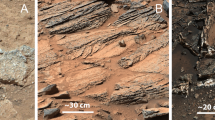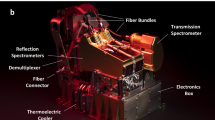Abstract
Micro-X is a sounding rocket-borne instrument that uses a microcalorimeter array to perform high-resolution X-ray spectroscopy. This instrument flew for the first time on July 22nd, 2018, from the White Sands Missile Range, USA. This flight marks the first successful operation of a transition-edge sensor array and its time-division multiplexing readout system in space. This launch was dedicated to the observation of the supernova remnant Cassiopeia A. A failure in the attitude control system prevented the rocket from pointing and led to no time on target. The onboard calibration source provided X-rays in flight, and it is used to compare detector performance during preflight integration, flight, and after the successful post-flight recovery. This calibration data demonstrate the capabilities of the detector in a space environment as well as its potential for future flights.






Similar content being viewed by others
Notes
The supernova remnant considered for this mission depends on the time of the year. The primary target (Puppis A) is not visible during the summer, so the secondary target was chosen for the first flight.
The silicon mesh provides mechanical support to the aluminum and polyimide films for the filters with larger diameters.
The integrated NEP is calculated using the optimal filter algorithm used in the XCAL GSE software discussed below, using an integral of the pulse shape and noise spectra [18].
Additional pixels with partial data do not add sufficient counts to help the fit when compared to the worse drift correction arising from the shorter observation.
References
P. Wikus et al., Proc. SPIE 7732, 77321P (2010). https://doi.org/10.1117/12.857034
K.D. Irwin, G.C. Hilton, Cryogenic Particle Detection (Springer, Berlin, 2005), pp. 63–149. https://doi.org/10.1007/10933596_3
D.C. Goldfinger et al., Proc. SPIE 9905, 99054S (2016). https://doi.org/10.1117/12.2233299
M.E. Eckart et al., AIP Conf. Proc. 1185, 699 (2009). https://doi.org/10.1063/1.3292437
D.C. Goldfinger, E. Figueroa-Feliciano, M.E. Danowski, S.N.T. Heine, J. Low Temp. Phys. 184, 699 (2016). https://doi.org/10.1007/s10909-016-1549-1
M.E. Danowski et al., J. Low Temp. Phys. 184, 597 (2016). https://doi.org/10.1007/s10909-016-1580-2
P.A.J. de Korte et al., Rev. Sci. Instrum. 74, 3807 (2003). https://doi.org/10.1063/1.1593809
G.M. Stiehl et al., IEEE Trans. Appl. Supercond. 21(3), 298–301 (2010). https://doi.org/10.1109/TASC.2010.2091483
B. Aschenbach, Exp. Astron. 26(1–3), 95–109 (2009). https://doi.org/10.1007/s10686-009-9163-8
R. Petre, X-ray Opt. Instrum. (2010). https://doi.org/10.1155/2010/412323
J.W. Percival, K.H. Nordsieck, K.P. Jaehnig, Proc. SPIE 7010, 70104H (2008). https://doi.org/10.1117/12.787917
S.N.T. Heine, High-Resolution Studies of Charge Exchange in Supernova Remnants with Magellan, XMM-Newton, and Micro-X, PhD Dissertation, Massachusetts Institute of Technology, 2014
D.C. Goldfinger, X-Ray Searches for Decaying Sterile Neutrinos with the Micro-X and XQC Sounding Rockets, PhD Dissertation, Massachusetts Institute of Technology, 2019
J.A. Rodriguez-Lopez, E. Figueroa-Feliciano, S. Leman, S. Kissel, Study on the KCl Fluorescent X-rays for the MicroX Imaging Rocket (2012)
D.C. Goldfinger et al., J. Low Temp. Phys. 193, 984 (2018). https://doi.org/10.1007/s10909-018-2060-7
G.M. Stiehl et al., IEEE Trans. Appl. Supercond. 21, 3 (2011). https://doi.org/10.1109/TASC.2010.2091483
C.D. Reintsema et al., IEEE Trans. Appl. Supercond. 29, 5 (2019). https://doi.org/10.1109/TASC.2019.2904594
XCal GSE v11.1.6 [software], NASA/GSFC (2019)
Acknowledgements
The Micro-X project is conducted under NASA Grant 80NSSC18K1445. Part of this work was performed under the auspices of the U.S. Department of Energy by Lawrence Livermore National Laboratory under Contract DE-AC52-07NA27344.
Author information
Authors and Affiliations
Corresponding authors
Additional information
Publisher's Note
Springer Nature remains neutral with regard to jurisdictional claims in published maps and institutional affiliations.
Rights and permissions
About this article
Cite this article
Adams, J.S., Baker, R., Bandler, S.R. et al. First Operation of TES Microcalorimeters in Space with the Micro-X Sounding Rocket. J Low Temp Phys 199, 1062–1071 (2020). https://doi.org/10.1007/s10909-019-02293-5
Received:
Accepted:
Published:
Issue Date:
DOI: https://doi.org/10.1007/s10909-019-02293-5




